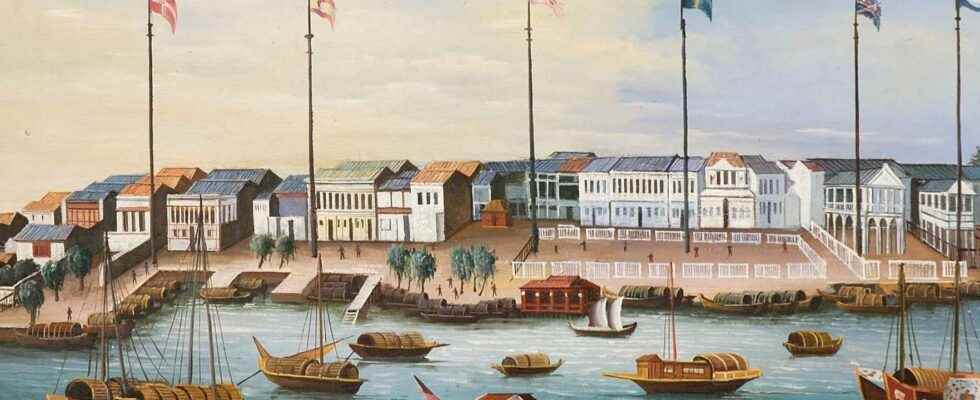The presence of Europeans in China and Japan remained episodic until the 17the century. These are two empires closed to trade with foreigners, which leave no freedom to Europeans as to the points of entry into their territories.
You will also be interested
Since the Portuguese discoveries of the XVIe century, the Asian maritime space is a fascinating world for Europeans because it opens up doors India, China or Japan. They find themselves faced with maritime civilizations with very ancient commercial activity, completely escaping the “world-economy” of the West. Between Europe and Asia, the sea route played a determining role from the moment when the browsers replaced the traditional land routes, traced by Marco Polo, and sea routes, with the passage of the Red Sea used by Arab merchants, with independent routes bypassing Africa (Vasco da Gama in 1498) or crossing the Pacific (Manila Galleon linking the Spanish Philippines to New American Spain as early as 1564).
China
The China is a continental country and a very old civilization, which hardly admits to trade with foreigners. The “Middle Kingdom” (the Chinese consider themselves to be the center of civilization, therefore in the middle of the world) considers the Europeans as barbarians who want to Christianize at all costs. China tolerates trade relations on the condition that Europeans pay taxes to be authorized to trade Chinese products (tea, silk, porcelain, etc.). Very few merchants have made it as far as Beijing: the Europeans remain in the ports, mainly Macauin the 16the century (Portuguese trading post since 1554), then Formosa in the 17the century (Dutch establishment dating from 1634). The Chinese prefer to use Indonesian and Philippine ports to sell their products to Europeans rather than selling them at home. Manila, in the Philippines, will become one of the few commercial contact centers between European and Chinese merchants.
It was not until the 1680s that China opened up more to trade with Europe, an indirect consequence of the increasingly strong rivalries between the English and the Dutch in Indonesia. In 1682, the Dutch captured the British port of Bantam on the island of Java and cut the Indonesian tea route to the English. The latter then made direct voyages to China and sent some forty merchant ships there between 1700 and 1715. The French in turn engaged in this new traffic: a Chinese company was even created in 1698, which brought first loading in 1700, coming from Canton.
Europeans remain dependent on the Chinese authorities who impose entry points into the country on them. In the south of the country, the ports of Macau and Canton are considered unattractive because they are far from the great Yangtze River (on which silk and porcelain arrive) and far from the city of Nanjing (outlet of the major tea-producing regions). European merchants will therefore try to go north but they are quickly dissuaded by the local mandarins (high officials of the Empire) who levy exorbitant duties on the goods. At the end of the XVIIe century, the port of Macao declined and its activity was limited to the shipment of silk to the Philippines; Canton becomes the main gateway to China and the English will direct all their ships there from 1711.
Japan
With the Japanthe trade situation was even more difficult for the Europeans who arrived at the end of the 16th century.e century. Suspicious of the West, the Shoguns (military governors general) ferment Japan to any foreign influence. They forbid the Japanese to move abroad and expel the Europeans, only tolerating Dutch merchants on the islet of Deshima, facing Nagasaki.
Christianity is seen as a threat to social balance, so it is brutally repressed. In the region of Nagasaki, the Christianized peasants were massacred or condemned to clandestinity. After 1635 and the introduction of isolationist laws, trade was both the monopoly of the Shogun, who remained the sole beneficiary, and of the Dutch East India Company which is authorized to send from Batavia (current Jakarta in Indonesia), two merchant ships per year. Weapons, books, coins are prohibited for import by the Japanese until the end of the 18th century.e century. The Dutch are authorized to sell fabrics, manufactured objects, spices which are of Asiatic origin; in return, they ship silks, porcelainlacquered furniture, sake, paper, so many goods highly appreciated in Europe from the middle of the 17th centurye century. It should be noted that porcelain from Japan and China is a very important element in the history of European taste and decorative arts in the 17th century.e and XVIIIe centuries.
The first Japanese in Europe
The samurai Hasekura Tsunenaga (1571-1622) was the first Japanese official sent to America. He led an embassy to New Spain, then to Europe, between 1613 and 1620. The purpose of the trip was to discuss commercial arrangements with the King of Spain, in Madrid, and to meet the Pope, in Rome. It thus allows the first known contact between French and Japanese, at the port of Saint-Tropez. Hasekura’s embassy arrives in Europe as Japan attempts to eradicate Christianity from its soil; the European monarchs therefore refused the commercial arrangements proposed by the samurai converted to Catholicism. He returned to Japan in 1620, his embassy having obtained no result for a Japan in full isolationism.
Interested in what you just read?
